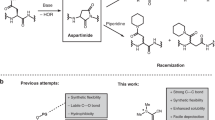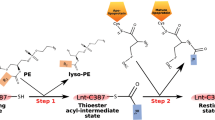Abstract
CARBOXYPEPTIDASE can split from peptide chains those terminal amino-acids that carry a free α-carboxyl group. The enzyme was used by Grassman et al.1 in demonstrating that the C-terminal residue of glutathione is glycine, and by Lens2 in studying the C-terminal residues of the peptide chains of insulin. Lens found that alanine is the end-group in two of the four chains of insulin, but was unable to identify the end-groups of the other two chains.
This is a preview of subscription content, access via your institution
Access options
Subscribe to this journal
Receive 51 print issues and online access
$199.00 per year
only $3.90 per issue
Buy this article
- Purchase on Springer Link
- Instant access to full article PDF
Prices may be subject to local taxes which are calculated during checkout
Similar content being viewed by others
References
Grassman, W., Dycherhoff, H., and Eibeler, H., Z. phys. Chem., 189, 112 (1930).
Lens, J., Biochim. et Biophys. Acta, 3, 367 (1949).
Fraenkel-Conrat, H., et al., J. Amer. Chem. Soc., 73, 625 (1951).
Green, F. C., and Shroeder, W. A., J. Amer. Chem. Soc., 73, 1385 (1951).
Thompson, A. R., Nature, 168, 390 (1951).
Work, E., Biochem. J., 42, xlix (1948).
Fisher, R. B., Parsons, D. S., and Morrison, G. A., Nature, 161, 764 (1948).
Author information
Authors and Affiliations
Rights and permissions
About this article
Cite this article
THOMPSON, A. The C-Terminal Residue of Lysozyme. Nature 169, 495–496 (1952). https://doi.org/10.1038/169495a0
Issue Date:
DOI: https://doi.org/10.1038/169495a0
This article is cited by
-
Chromatographie de déplacement des aminoacides et de leurs dérivés sur colonne d'échangeurs d'ions á trame hydrophile
Chromatographia (1969)
-
Sur l'identification des résidus C-terminaux d'une protéine après hydrazinolyse
Experientia (1964)
-
Bestimmung der carboxylendst�ndigen Aminos�uren des Caseins
Zeitschrift f�r Lebensmittel-Untersuchung und -Forschung (1963)
-
Occurrence of Citrulline in Proteins
Nature (1962)
Comments
By submitting a comment you agree to abide by our Terms and Community Guidelines. If you find something abusive or that does not comply with our terms or guidelines please flag it as inappropriate.



